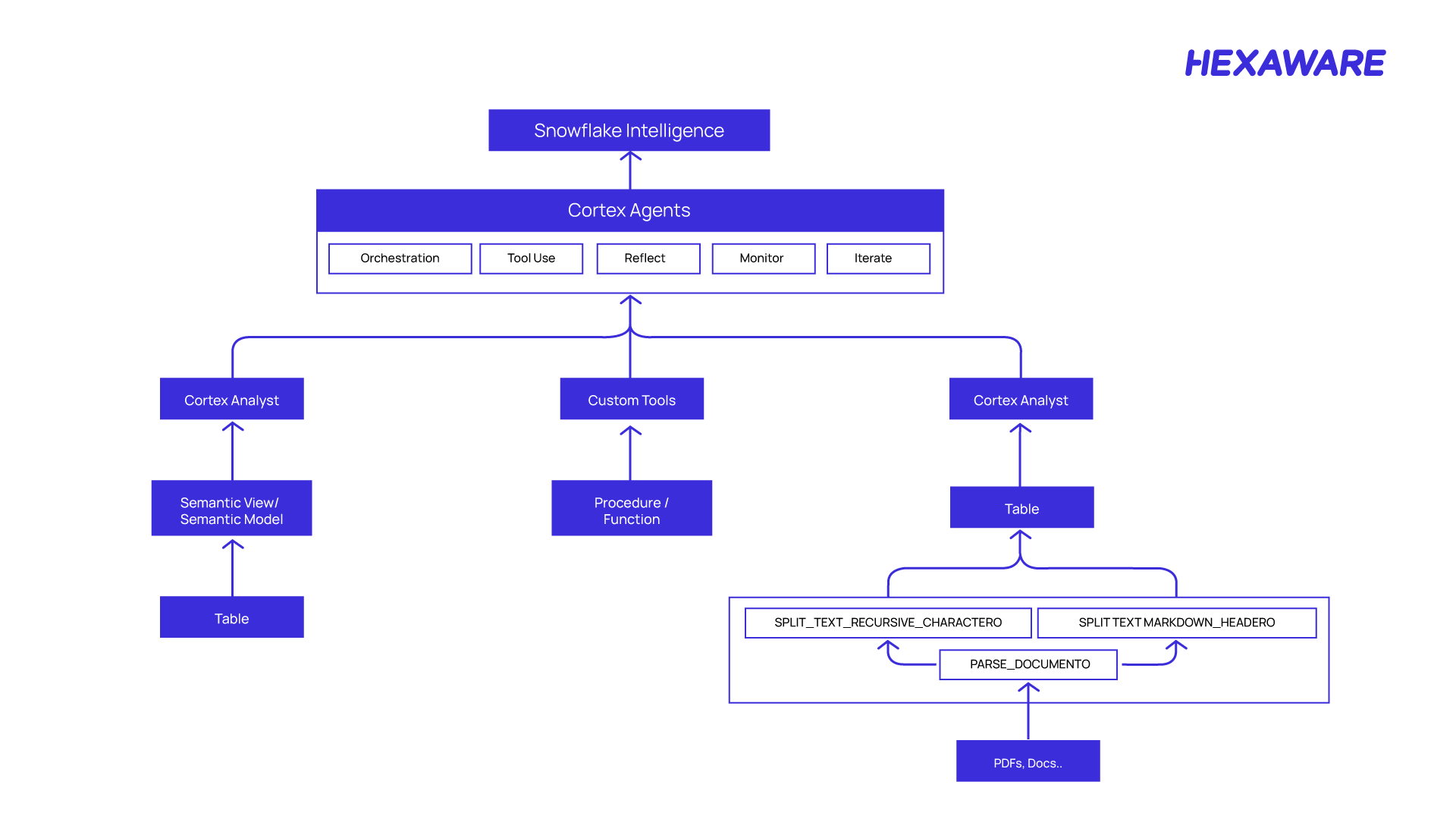Once, data lived behind walls — accessible only to analysts and IT teams. But today, every enterprise wants its people to move faster: to ask the right questions, act on insights, and decide with confidence. That’s where self-service analytics emerged — not just as a technology shift, but as a movement to democratize data, empower decision-makers, and make trusted insights available to everyone.
Yet, true self-service for enterprises has always been elusive — constrained by complexity, silos, and governance challenges.
Snowflake Intelligence: Where Self-Service Meets Enterprise AI
Enter Snowflake Intelligence, a transformative leap in self-service analytics that fuses enterprise data, AI, and governance into one secure, conversational experience.
In this two-part blog, we’ll explore how self-service analytics evolved over the last two decades and how Snowflake’s latest innovations — Snowflake Intelligence and Cortex Agents— finally deliver on its original promise.
- Part 1: How self-service changed — What does AI-driven analytics replace
- Part 2: The promise of self-service — How Snowflake Intelligence delivers it
How Has Self-Service Analytics Transformed Over Years
The idea of self-service analytics was born from a simple need — to free business users from their dependence on IT and give them the power to explore data on their own.
Over time, what started as a vision for empowerment has evolved through multiple waves of technology and mindset shifts. Understanding this journey helps explain why today’s enterprises are still striving to achieve truly frictionless, intelligent self-service.
Self-Service 1.0: Semantic Models & Ad-hoc Reporting
Early self-service meant IT-controlled access through semantic models and reporting tools like Cognos and BusinessObjects. It brought governance, but agility suffered — every change still needed IT intervention.
- Takeaway: Reliable reporting, yet slow and IT-driven.
Self-Service 2.0: Dashboards & Visualization
Dashboards made analytics visual and accessible. Tools like Tableau and Power BI empowered “citizen analysts.” But data stayed trapped in tool silos, limiting scale and consistency.
- Takeaway: Democratized insights, but fragmented control.
Self-Service 3.0: Auto-Insights & Embedded Analytics
Automation surfaced patterns and anomalies directly in business apps.
Still, disconnected systems and governance gaps restricted trust and reuse.
- Takeaway: Actionable insights, yet inconsistent and siloed.
Self-Service 4.0: Conversational & Intelligent
The era of generative AI reimagined self-service — users could ask, interact, and decide through natural language. Snowflake takes this leap further with Snowflake Intelligence, uniting data, AI, and governance into a single, secure conversational experience.
- Takeaway: The true state of self-service — intelligent, governed, and built for the enterprise.
Each wave of self-service analytics brought enterprises closer to true data democratization — but also revealed new limits around scale, trust, and governance. With Snowflake Intelligence, those limits finally dissolve, giving rise to a secure, conversational, and intelligent era of self-service.
What’s New for Self-Service with Snowflake Intelligence
Snowflake Intelligence is an agentic AI experience that enables business users to derive fast and accurate insights from both structured and unstructured data — all through natural language, within a hosted, secure interface (ai.snowflake.com).
By introducing a secure, conversational AI experience for every user, Snowflake Intelligence uses Cortex Agents, APIs, tools, and LLMs to empower non-technical users to “talk to their data,” create visualizations, and run deep analyses — all without a single line of code.
How Does Snowflake Intelligence Deliver What’s Promised
To understand how Snowflake Intelligence delivers a unified, agentic experience, let’s look at its layered architecture — bringing together data, governance, tools, and user interaction.

An end-to-end intelligent data platform for insights delivery
Level One: The Data Layer for Enterprise Knowledge
At the foundation lies the data layer, which serves as the single source of truth. All enterprise data — structured and unstructured — resides securely in Snowflake. Whether it’s application data, databases, or documents, everything is ingested, governed, and made accessible to AI through a unified layer.
Level Two: The Data Governance Layer with Snowflake Horizon
Governance is central to Snowflake’s design. Snowflake Horizon Catalog ensures every insight remains trusted, compliant, and traceable by providing:
- Role-based access control and data policies to manage permissions.
- Data classification, lineage, and auditing for transparency.
- Secure access control mechanisms to protect sensitive information.
Level Three: The Tools Layer with Cortex Analyst, Cortex Search, & Custom Tools
This layer contains the core analytical components of Snowflake Intelligence.
- Cortex Analyst handles structured data using Snowflake tables and semantic models. Users can query using natural language, and responses are generated based on curated business semantics.
- Cortex Search focuses on unstructured data like PDFs and documents. Content is extracted, chunked, and stored in Snowflake, enabling secure retrieval without moving data outside the platform.
- Custom Tools allow developers to extend Snowflake Intelligence with stored procedures and business-specific logic — adding custom reasoning capabilities to fit enterprise contexts.

Flow of Snowflake Intelligence integrating data, tools, and orchestration
Level Four: Cortex Agents for the Orchestration Layer
At the heart of Snowflake Intelligence lies Cortex Agents — orchestrators that coordinate data flow, tool selection, and reasoning. They manage interactions between components and ensure responses are optimized for accuracy and performance.
They perform several critical functions:
- Orchestration: Managing flow between sources, models, and tools.
- Tool Use: Selecting and invoking the right analytical function.
- Reflection: Evaluating response quality before final output.
- Monitoring: Tracking performance and usage for optimization.
- Iteration: Learning from each cycle to refine results.
Level Five: User Interaction Layer with Snowflake Intelligence
Finally, the Snowflake Intelligence interface offers a simple yet powerful user experience.
Snowflake Intelligence provides a hosted conversational interface where users can interact naturally with data.
In addition to the hosted interface, enterprises can:
- Embed Snowflake Intelligence into internal applications, or
- Customize it with their own branding and UX for domain-specific experiences.
Below are some snapshots of running Snowflake intelligence. We ran it on our certification data.

Illustration: Thinking and Reasoning

Illustration: Results and Response

Illustration: Augmented with Visuals
Best Practices for Implementing Snowflake Intelligence
While the technology is powerful, the success of Snowflake Intelligence depends on thoughtful implementation. The following best practices help enterprises maximize value and adoption.
Build Strong Data and Semantic Foundations
Start by ensuring your data is well-organized and semantically rich.
- Create semantic models aligned with real business concepts.
- Maintain clear data lineage with layered environments (Raw → Curated → Gold).
Strengthen Governance and Security
Governance ensures trust and compliance in agentic AI systems.
- Use RBAC and audit logs for complete transparency.
- Treat every AI agent as a governed entity with its own permissions and oversight.
Optimize for Performance and Cost
Track and manage compute consumption to control cost without compromising performance.
- Monitor model and warehouse usage.
- Use separate compute warehouses for Snowflake Intelligence workloads to isolate costs.
Start Small — Prove Value Early
Adoption works best when driven by tangible business impact.
- Begin with clear, high-impact use cases (e.g., marketing analytics, supply chain visibility, revenue forecasting).
- Scale adoption once measurable value is demonstrated.
Monitor, Learn, and Improve Continuously
Make Snowflake Intelligence a learning system — both technically and culturally.
- Use feedback mechanisms like thumbs-up/down to refine model accuracy.
- Track user behavior and query types to tune semantic models.
Hexaware’s Use Cases of Snowflake Intelligence
To demonstrate the real-world potential of Snowflake Intelligence, here are two live examples from Hexaware’s implementations:
- Electronics Retailer:
Built a real-time Supply Chain Analytics & Insights platform on Snowflake Intelligence to help track global shipments and operational KPIs. - Industrial Manufacturer:
Developed a custom conversational app using Cortex Agents to surface insights from parts manuals, product documentation, and operational data.
The Future of Self-Service is Increasingly Agentic
The journey of self-service analytics has been a steady evolution — from IT-controlled reporting to true data democratization. Snowflake Intelligence marks the turning point where self-service becomes intelligent, secure, and context-aware.
By combining conversational interfaces, LLMs, semantic reasoning, and built-in governance, Snowflake is redefining how businesses access and act on data — finally fulfilling the long-promised vision of self-service analytics.
Hexaware for Self-Service Analytics with Snowflake Intelligence
To explore how Snowflake Intelligence can accelerate your enterprise self-service analytics journey, partner with experts who’ve done it before. Hexaware is an Elite Snowflake Partner with deep expertise in delivering AI and analytics solutions for 30+ Snowflake customers.
Learn all about our Snowflake partnership benefits, services, and solutions.




















